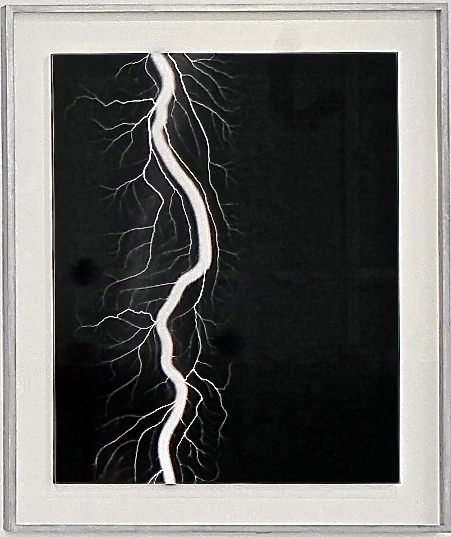Based in New York and Tokyo, Hiroshi Sugimoto is widely regarded as one of the most significant photographers of his generation. Pushing the limits of his medium, Sugimoto combines experimental photographic techniques with interdisciplinary installations, more recently expanding his practise into architecture and literature.
Included in RE:VISION at Trish Clark Gallery is a work from Sugimoto’s 2009 series Lightning Fields. Giving the keynote presentation at the17th Biennale of Sydney, in which he presented an electrifying installation at the power generating plant on Cockatoo Island, Sugimoto explained how these images were conceived and executed utilising photographic techniques without the use of a camera. Inspired by the 19th century pioneer of modern day photography, William Henry Fox Talbot and the 18th century scientist Benjamin Franklin, these works are produced in the darkroom using a 400,000 volt Van de Graaff generator as well as various devices of the artist’s own design. Images that resemble lightning and other biomorphic forms are the result of electrical current applied directly to photographic plates. Sugimoto says of these works: ‘The idea of observing the effects of electrical discharges on photographic dry plates reflects my desire to re-create the major discoveries of these scientific pioneers in the darkroom and verify them with my own eyes.’
Sugimoto’s formidable career spans four decades. Graduating in 1970 from Saint Paul’s University, Tokyo with a BA in politics and sociology, he then travelled to Los Angeles and enrolled at the Art Centre College of Design. After graduating with a BFA in 1974, Sugimoto migrated to New York City where he continues to be based. Since the late 1970s Sugimoto’s parallel photographic series, most notably Dioramas (1977-1999), Theatres (1978-2001), Seascapes (1980-2002) and Architecture (1977-2002), have been exhibited extensively internationally. In recent years, Sugimoto has expanded his field of activity into architectural work, founding the New Material Research Laboratory in 2008, an architectural design office that was commissioned to design the Izu Photo Museum in Shizuoka prefecture. His recent texts include Sense of Space published by Magazine House, and Origin of Art by Shincho-sha. As a connoisseur of traditional arts and theatre, Sugimoto has led the direction of Ningyo Joruri Bunraku (Japanese puppet theatre) production of Sugimoto Bunraku Sonezaki Shinju: The Love Suicides at Sonezaki, which was performed in Madrid, Rome, and Paris in autumn 2013 and again in Tokyo and Osaka in March 2014. His international awards include the 21st Praemium Imperiale in 2009, a Medal of Honor with Purple Ribbon by Japanese Government in 2010, and the Officier dans l’Ordre des Arts et des Lettres (The Order of Arts and Letters) by the French Government in 2013.

